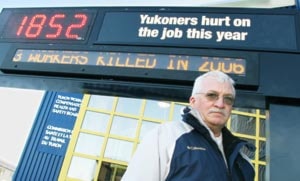So far in 2006, three people have died on the job.
Another 1,858 workers have been reported injured.
That’s 10 per cent of the Yukon’s workforce.
Now a sobering reminder of the injured workers has been erected in front of Whitehorse’s Yukon Workers Compensation Health and Safety Board building on Fourth Avenue.
The board has put up a black sign with red numbers chronicling the number of injuries in the Yukon.
Since yesterday, the tally has increased by six.
“Not one of these injuries were unavoidable and not one of them were just the cost of doing business,” said board president Craig Tuton, while unveiling the sign on Thursday.
Tuton also officially announced the 2007 employer rate hikes.
Most industries and businesses are looking at 15- to 20-per-cent rate hikes, according to a leaked Workers’ Compensation Health and Safety Board order, which was signed off in October.
Hit hardest are building-construction employers with an 85-per-cent hike from 4.79 to 8.89 per $100 of payroll.
The Yukon government and First Nations rates hold steady at 2.02.
Resource sectors, like placer mining, mapping and gravel crushing, will see a 19-per-cent hike — to 4.18 from 3.51 per $100 of payroll.
Diamond drilling and outfitting will see a 17 per cent hike.
Professional offices will see a 26-per-cent increase, with rates rising to 1.09 from 0.86 and hotels, motels and lodges will pay nearly 19-per-cent more.
The increases bring the Yukon’s average assessment rate to 2.64.
That makes the territory’s rates third-most expensive in the country — after Nova Scotia at 2.65 and Newfoundland and Labrador, which hasn’t reported its final rates for 2007, but early indications show it will sit around 2.75.
Driving the increases in the Yukon are the phasing out of subsidies, the high volume of claims and their duration, which can be on average more than 100 days each.
This year, employers will pay high premiums to keep pace with rising claims costs, said Tuton.
“You’re actually starting to pay more along the lines of what you’ve been costing the system.”
The maximum wage rate for 2007 will also rise to $73,200, up from $69,500 in 2006.
So even if an injured worker makes more than that annually, the benefits top out at 75 per cent of $73,200.
“That’s pretty high,” said Tuton. “If that number seems a little extreme to you, we can’t help it, but the politicians can.”
Workers Compensation also unveiled a new incentive program, dubbed CHOICES, to reward employers based on their efforts in occupational health and safety and return-to-work programs. (LC)
